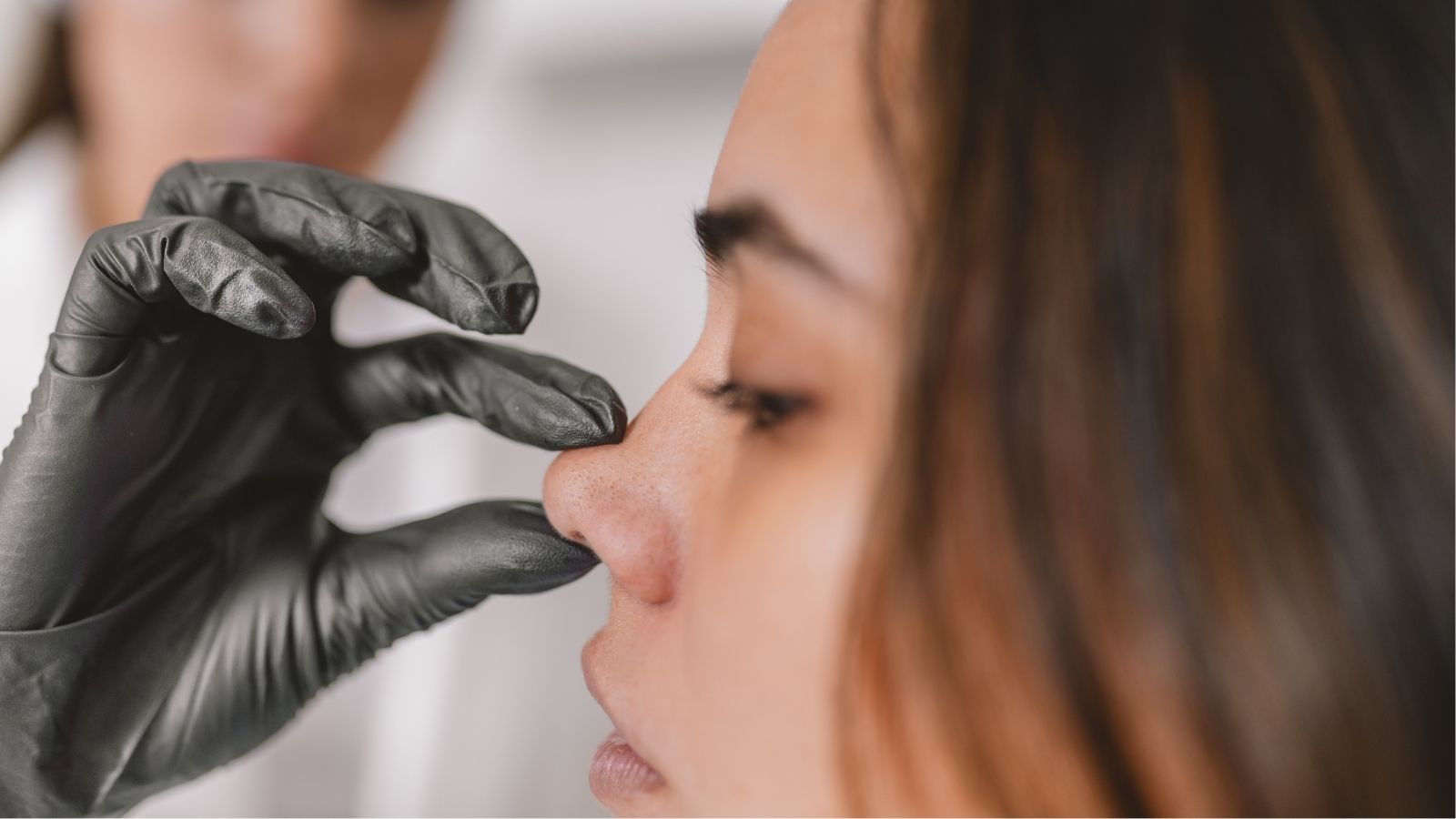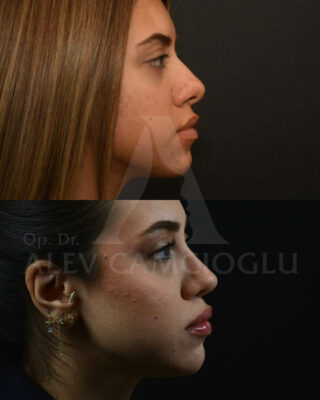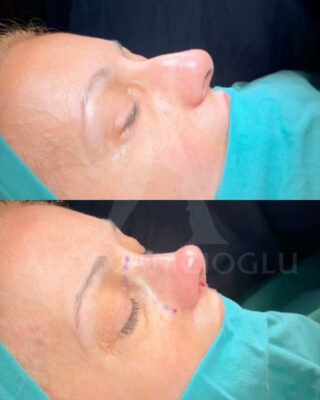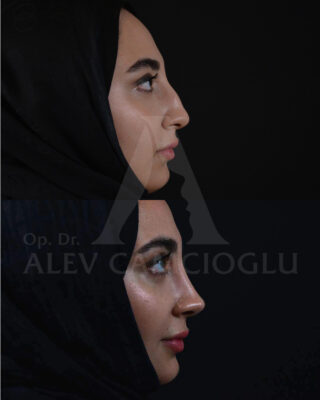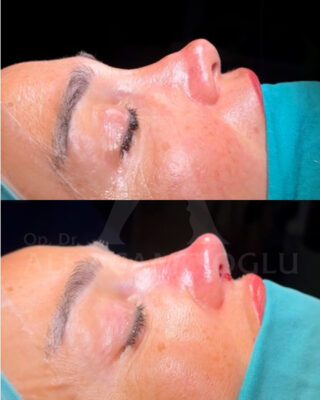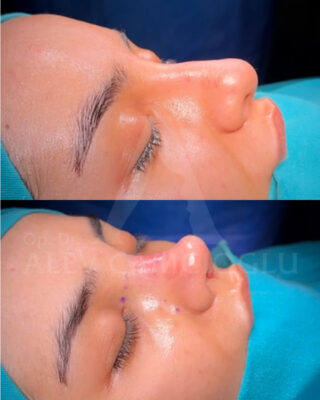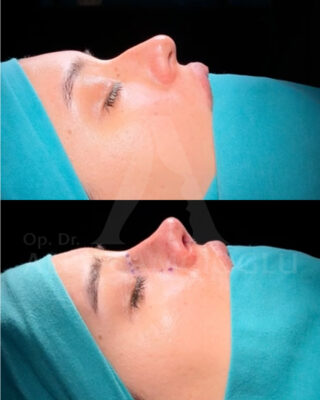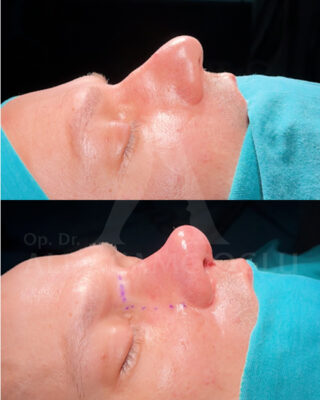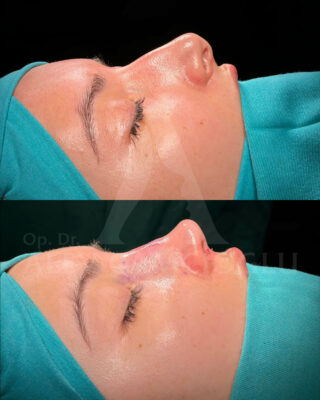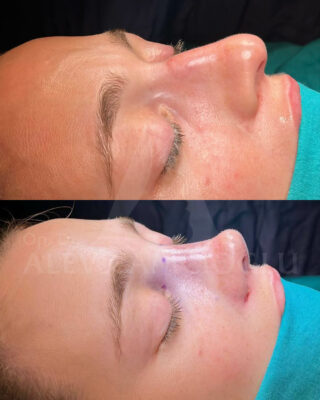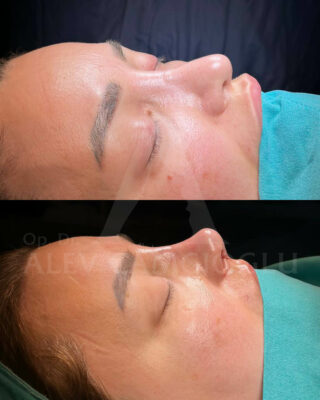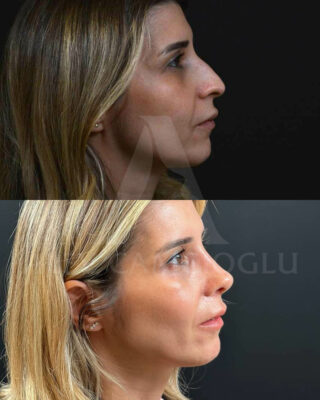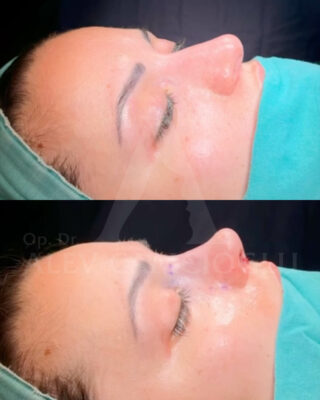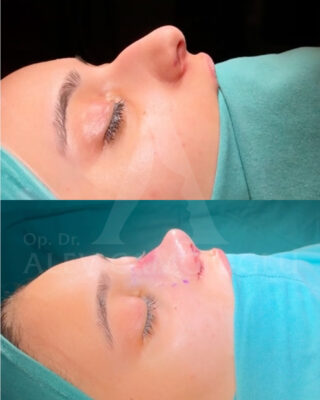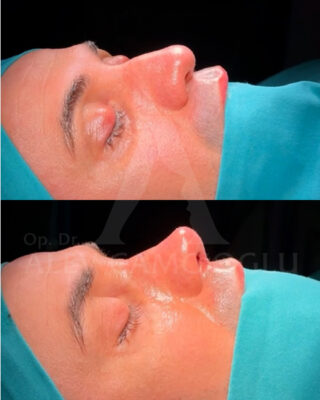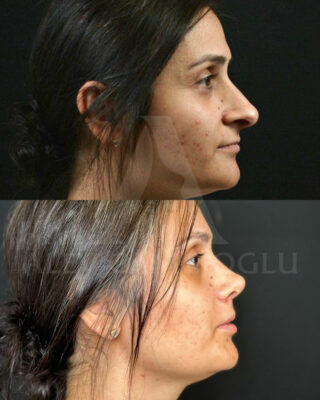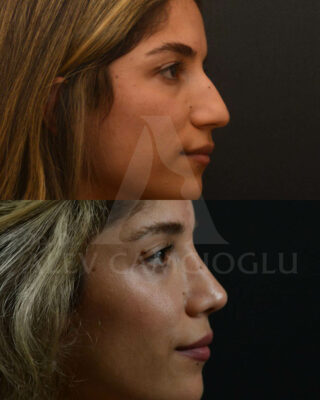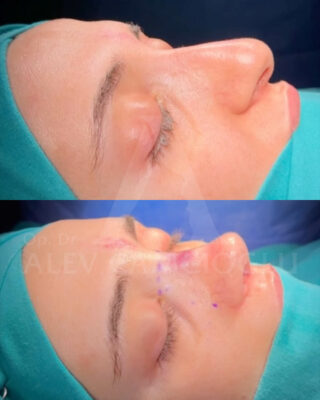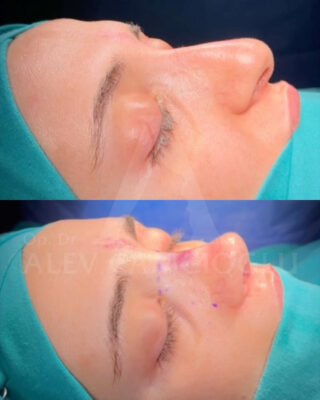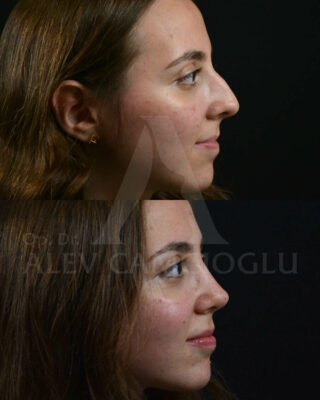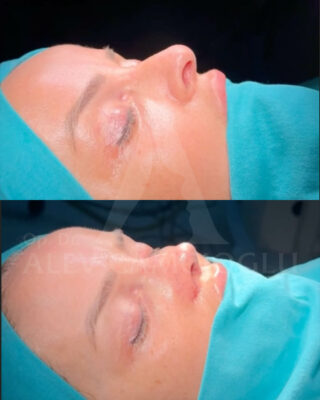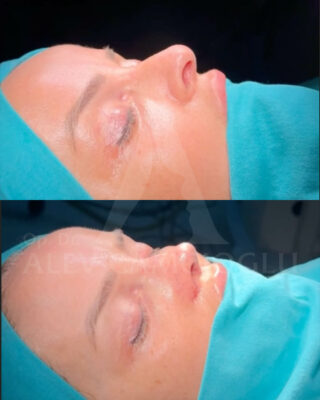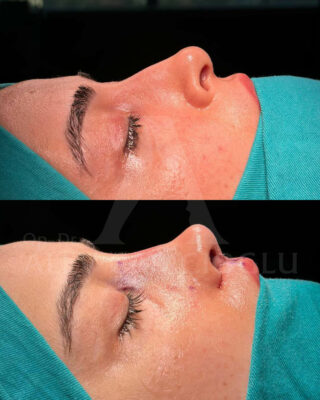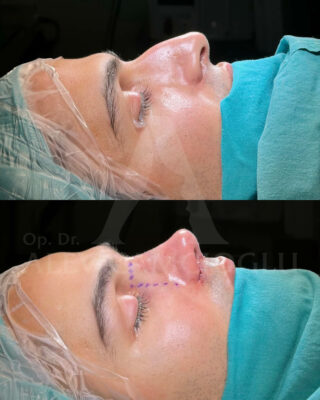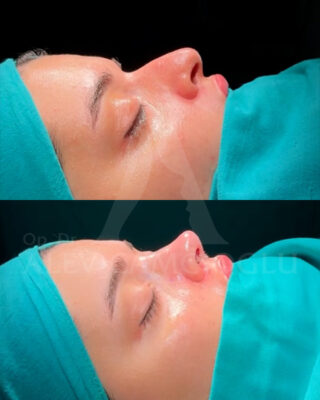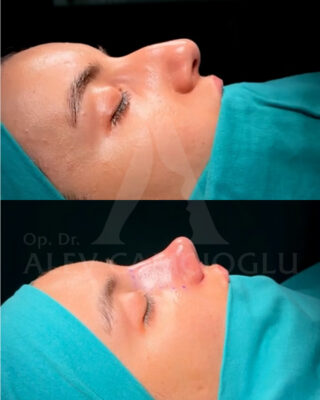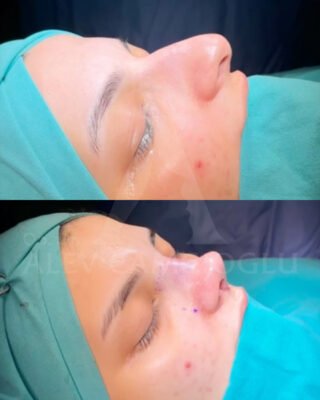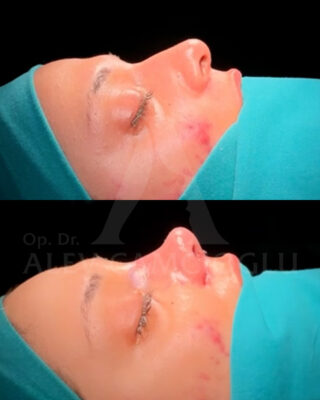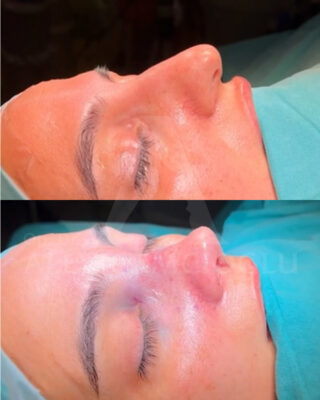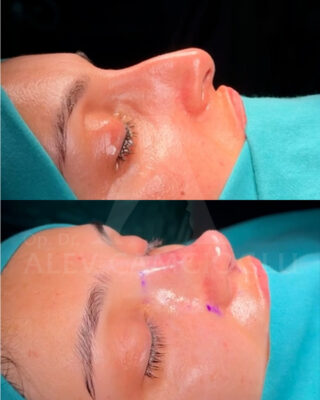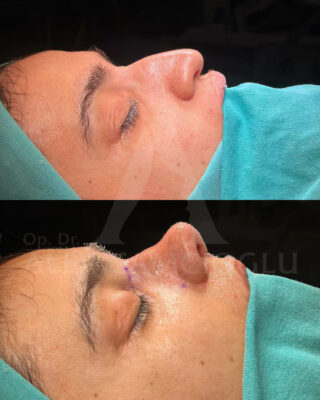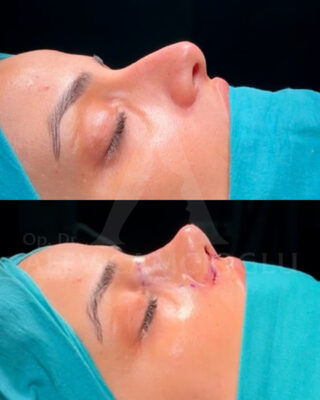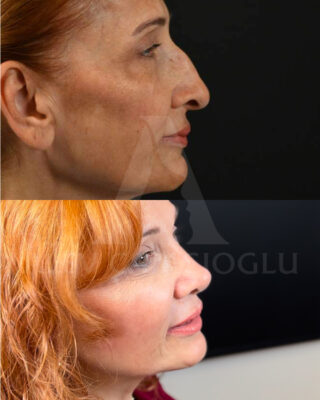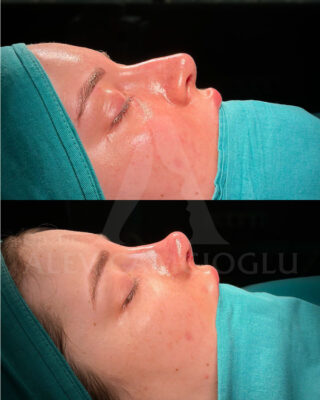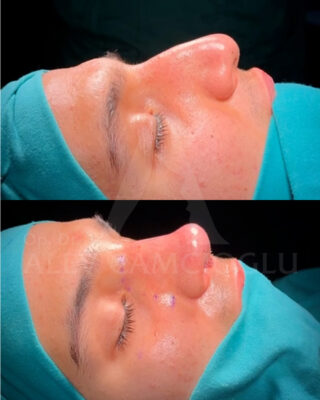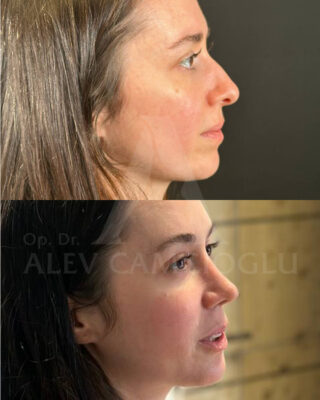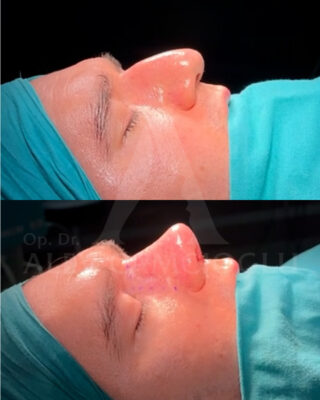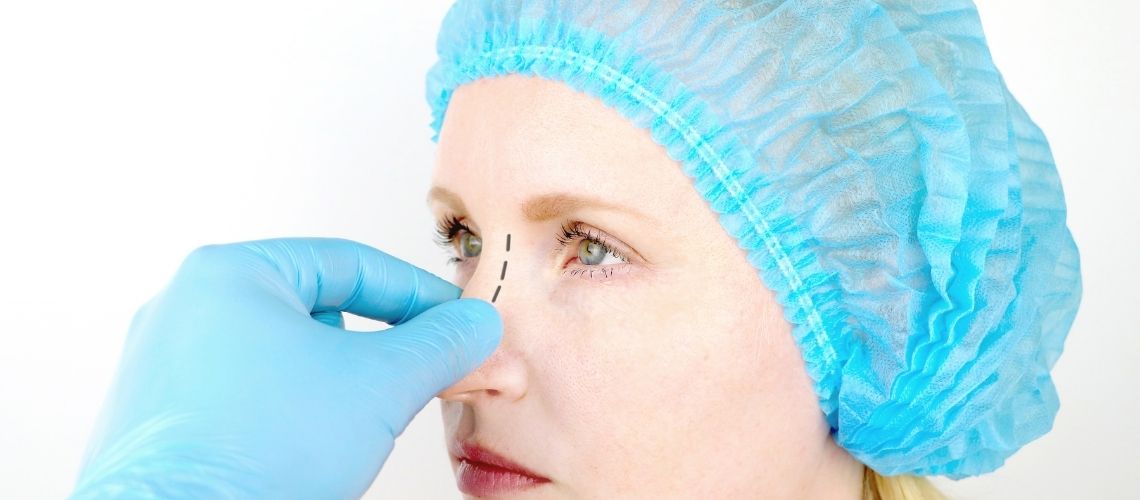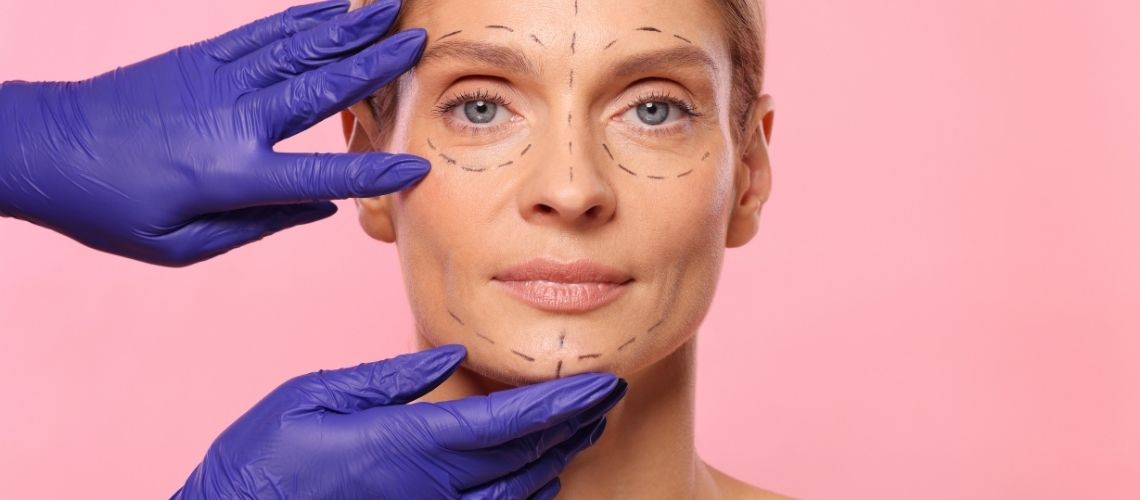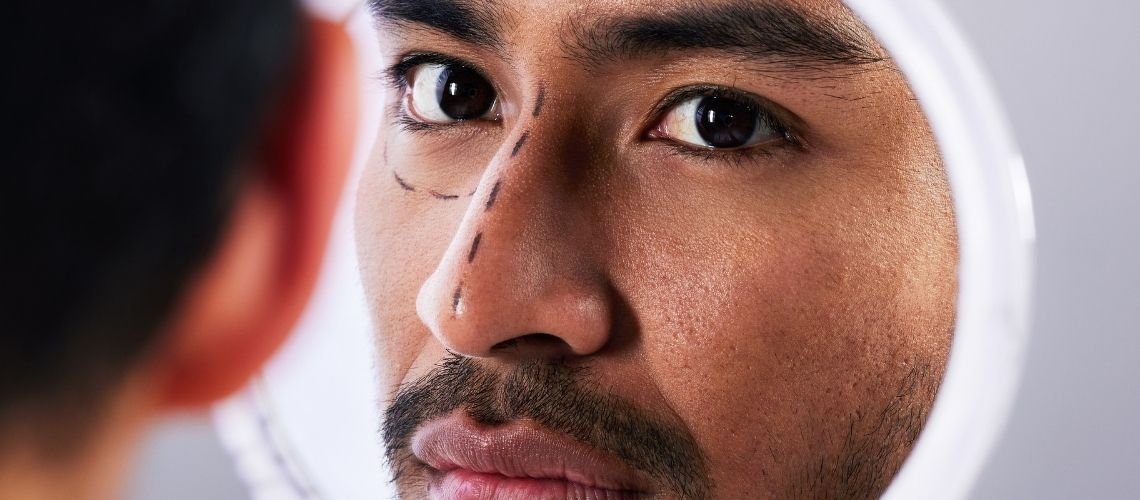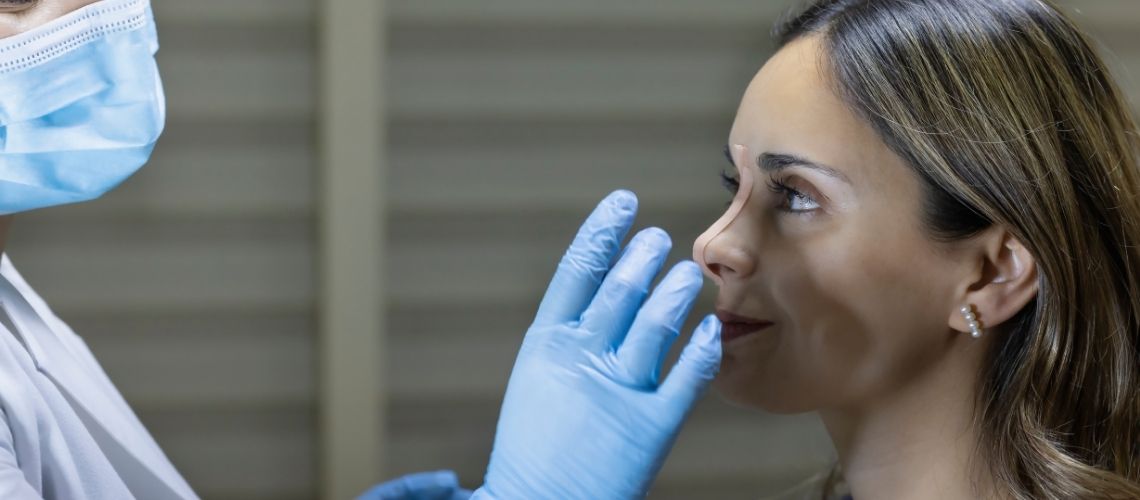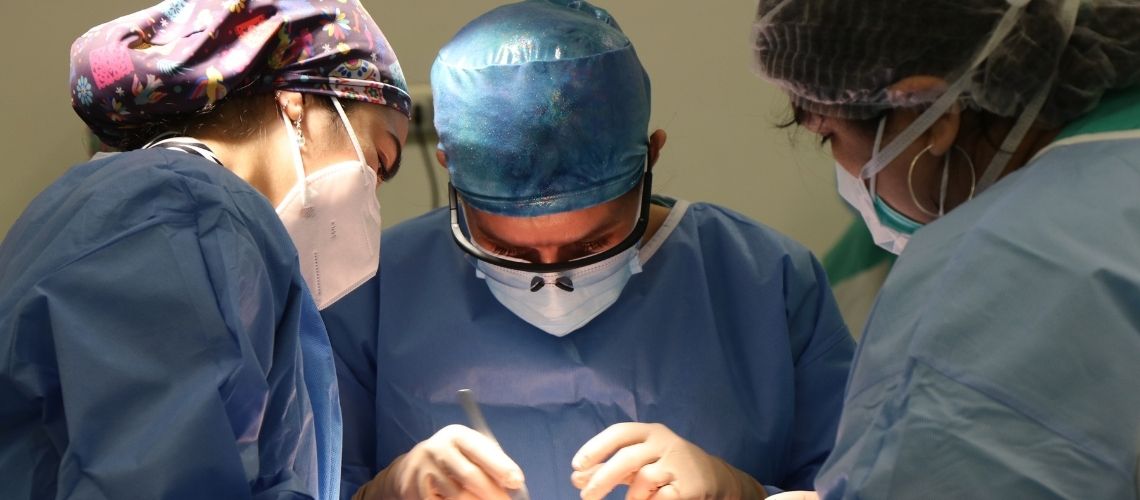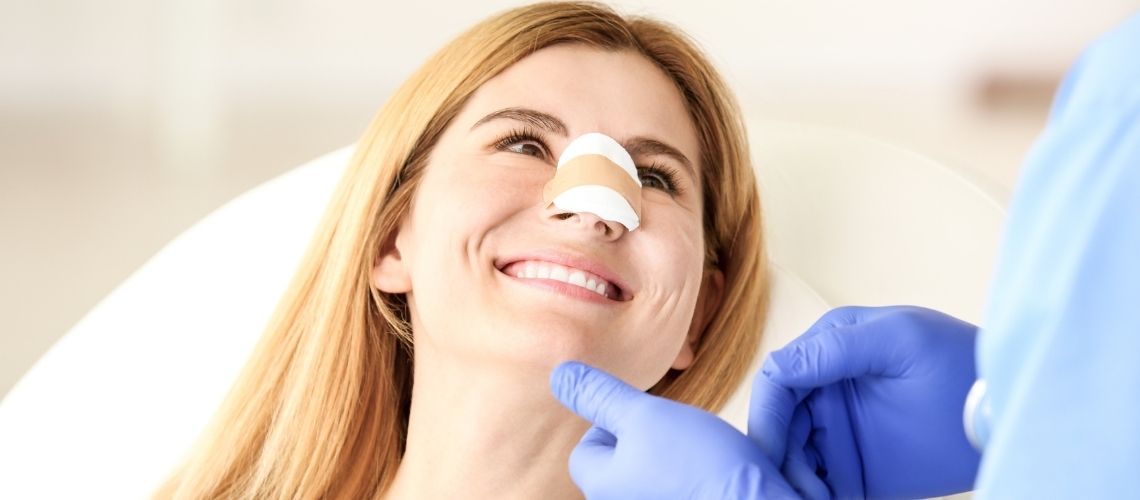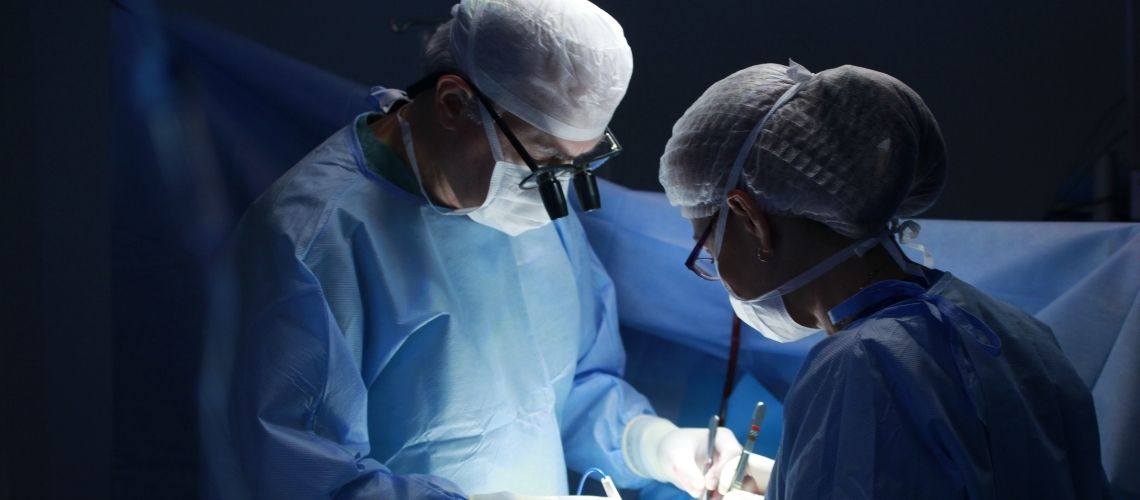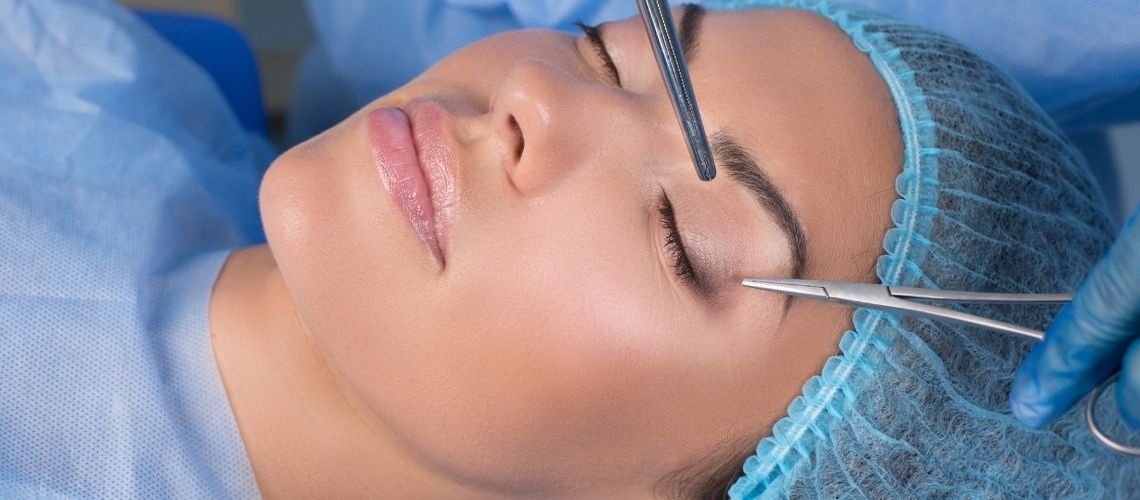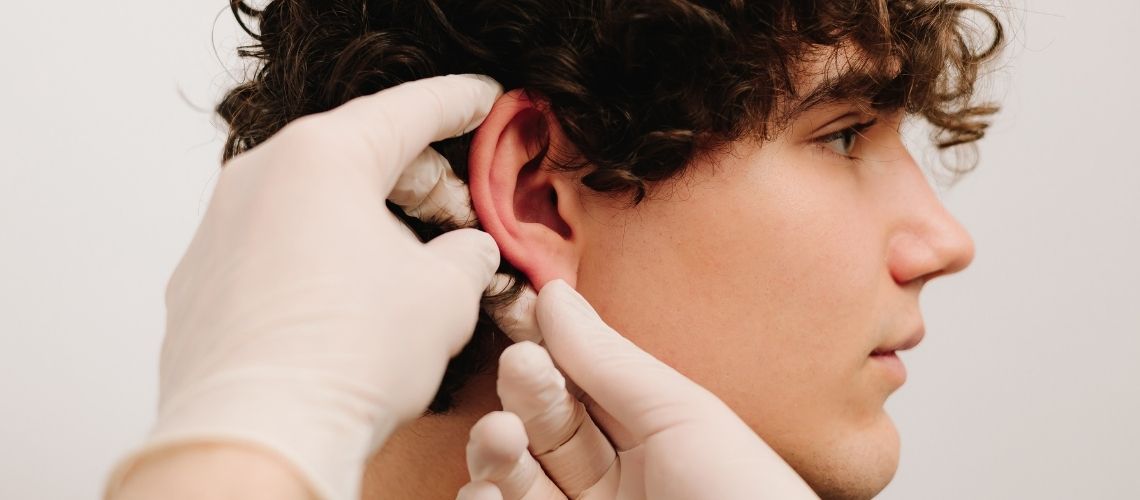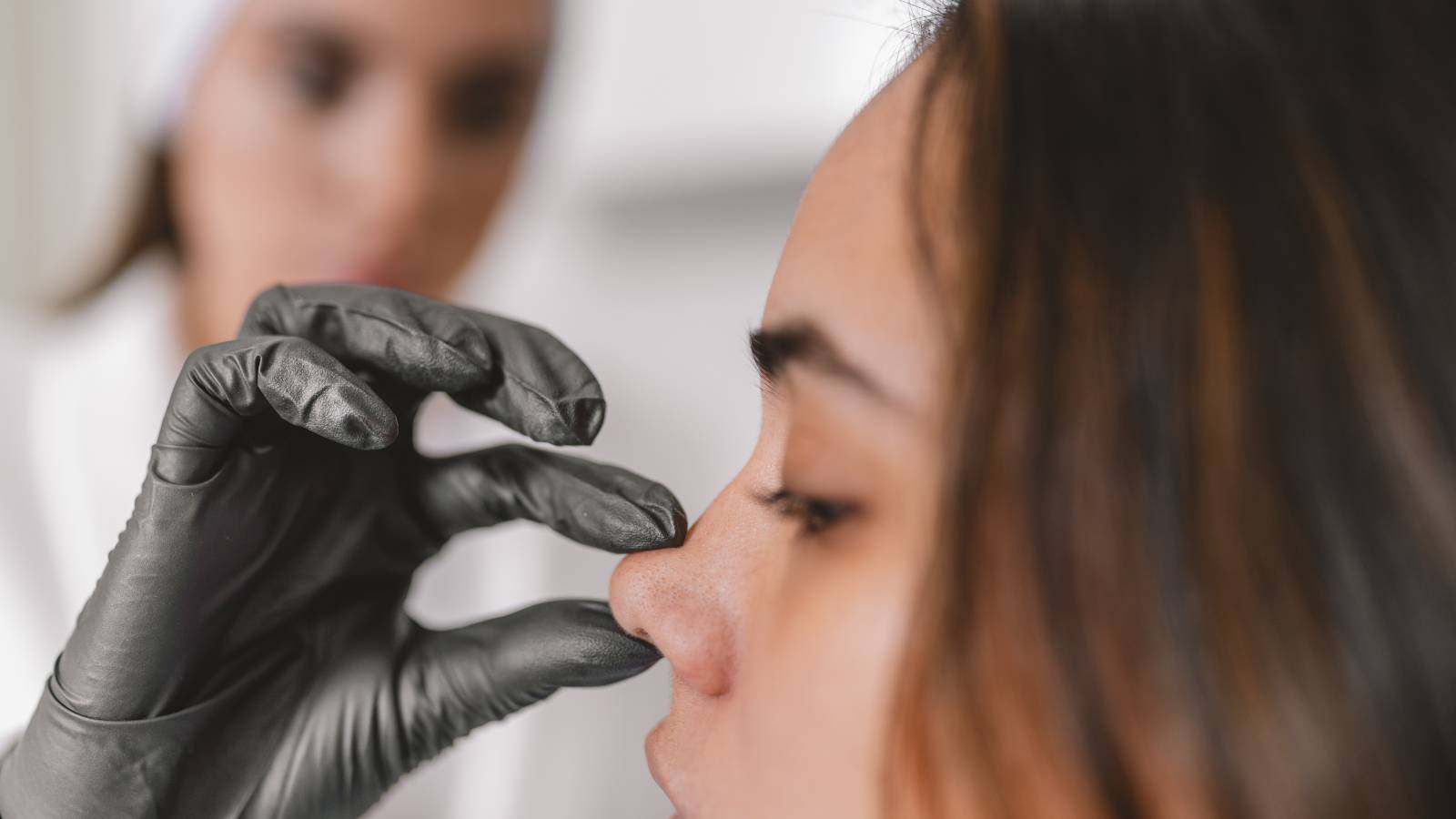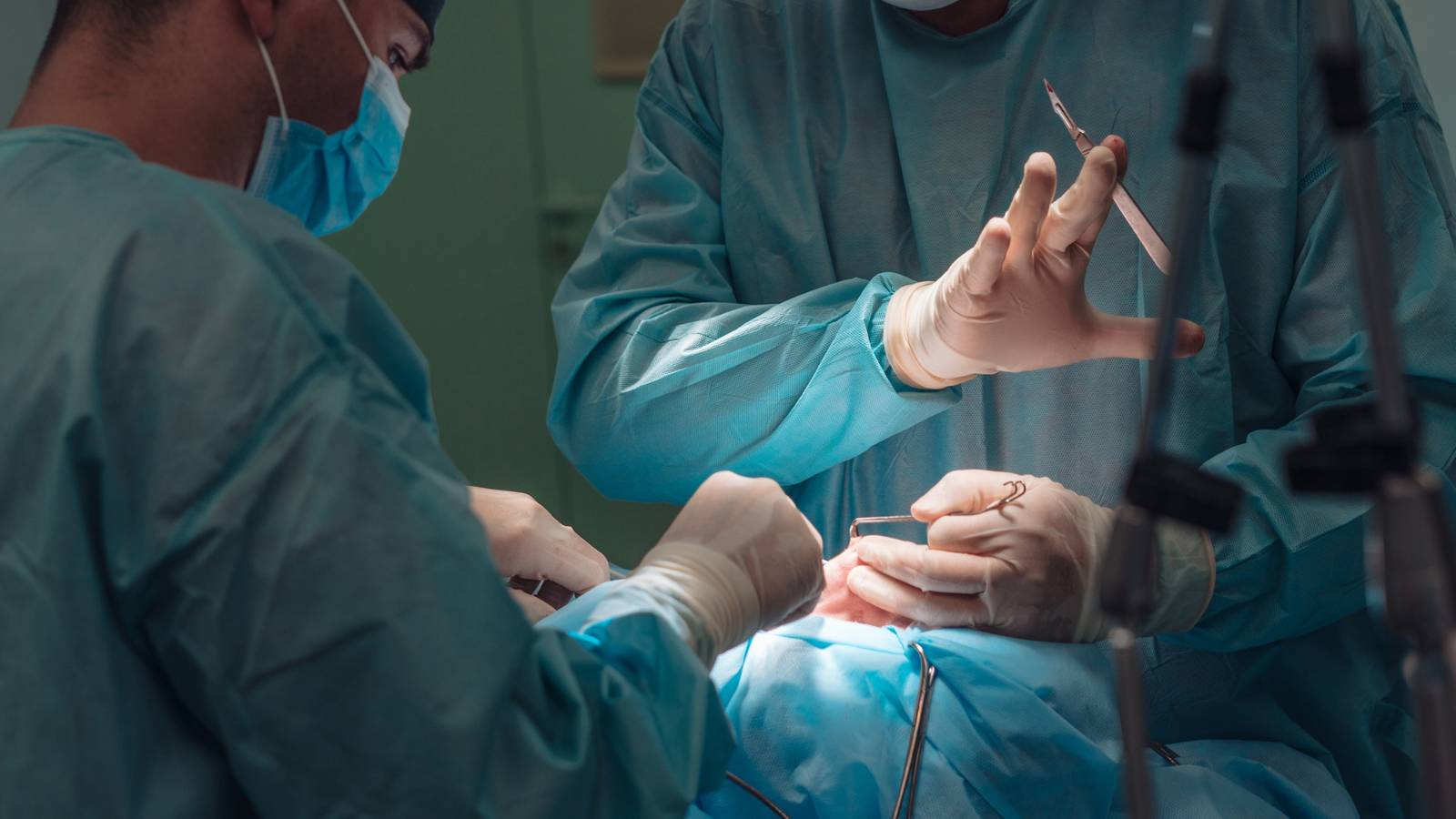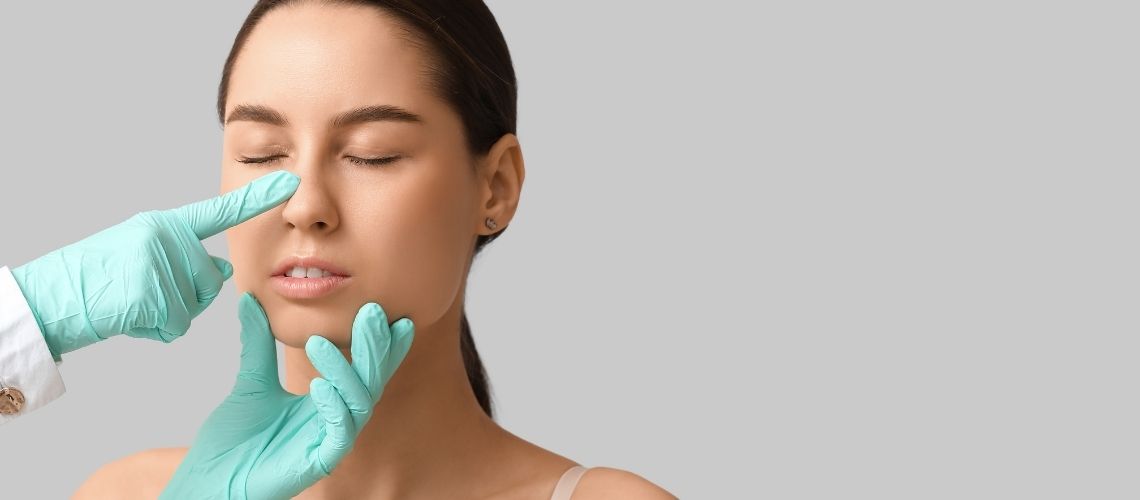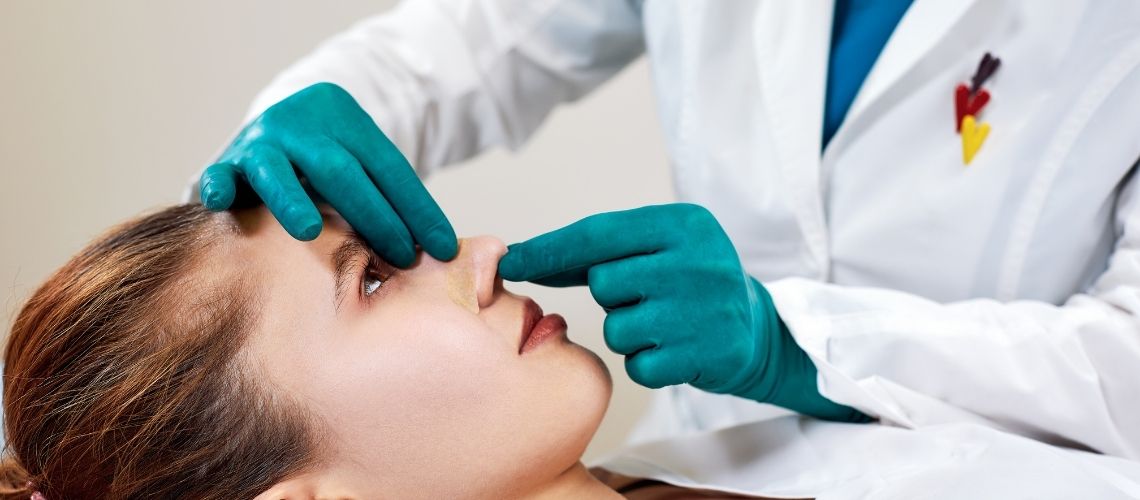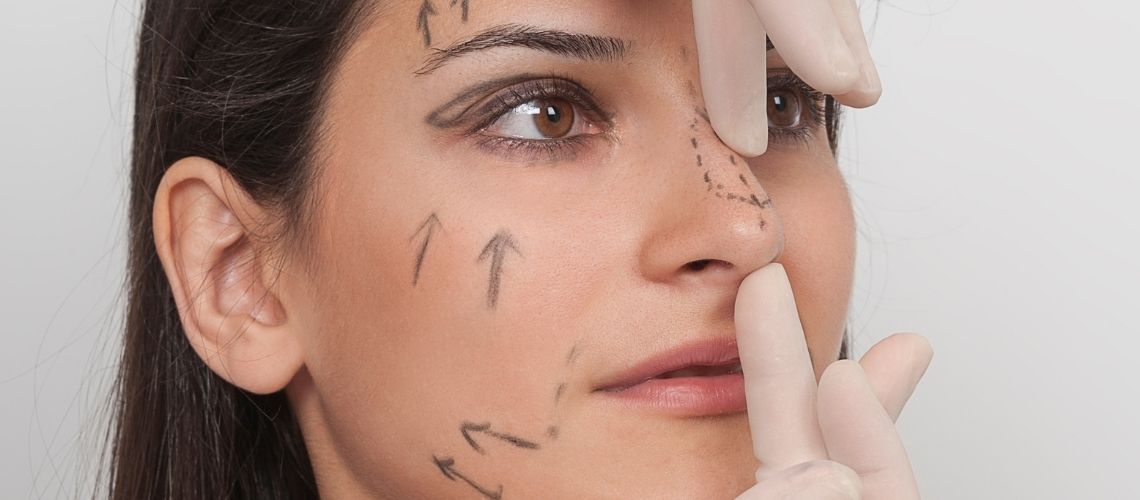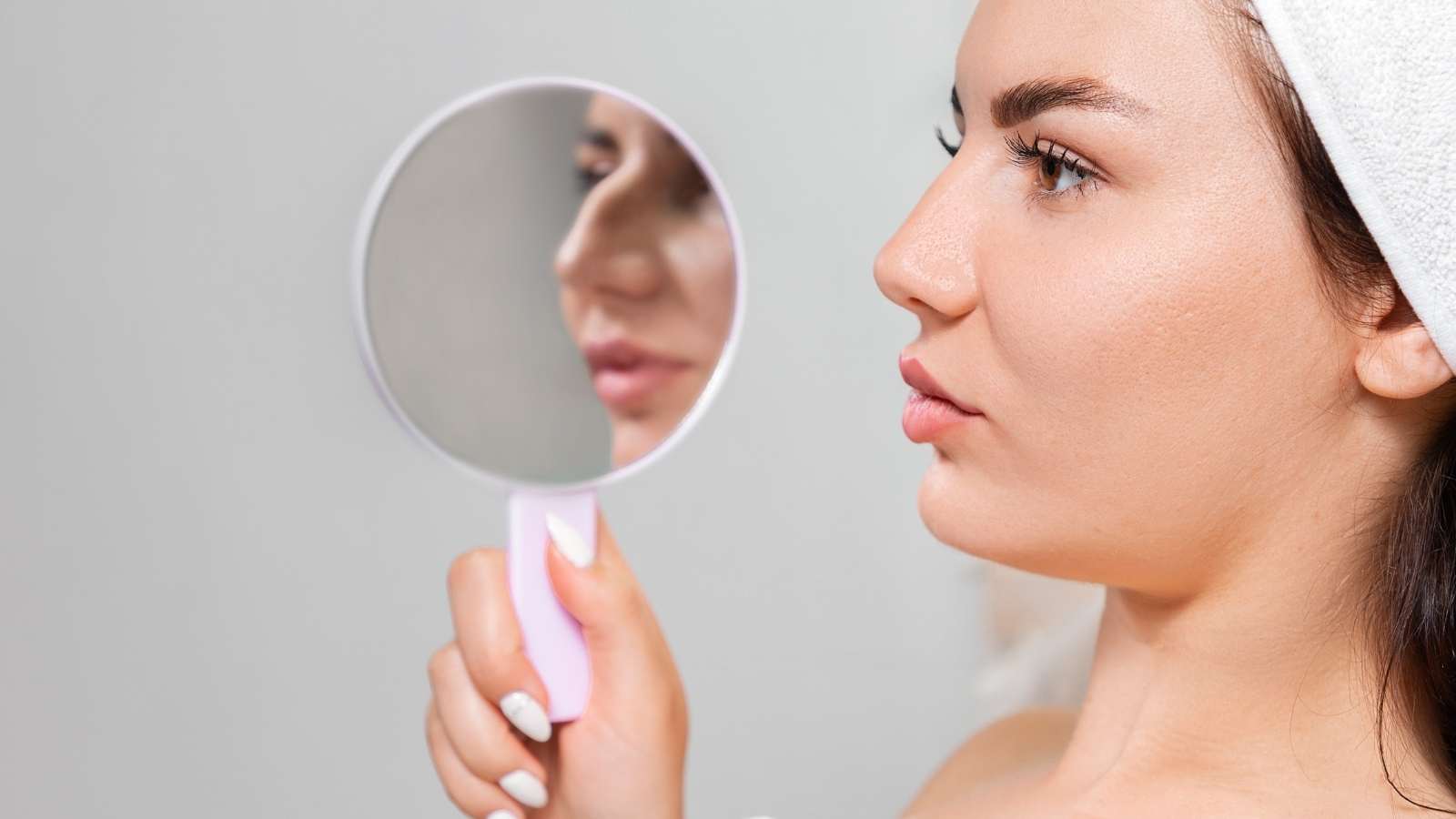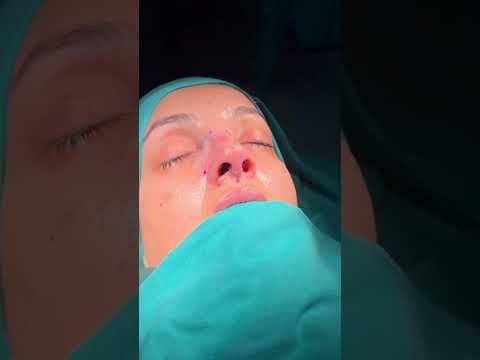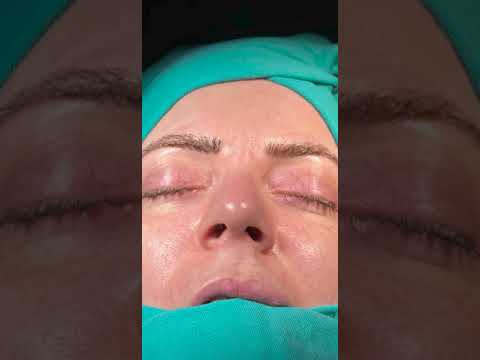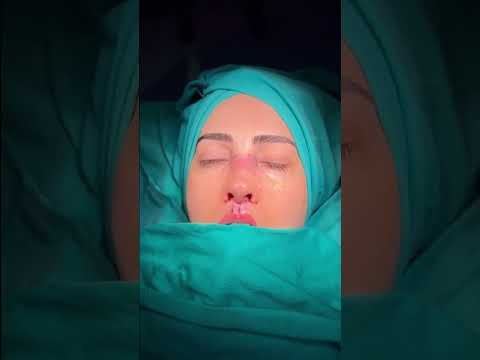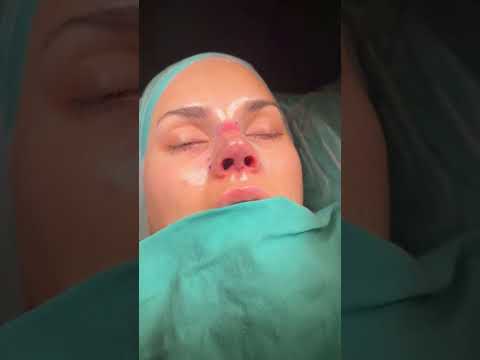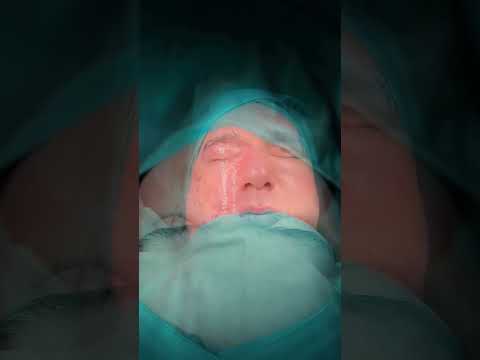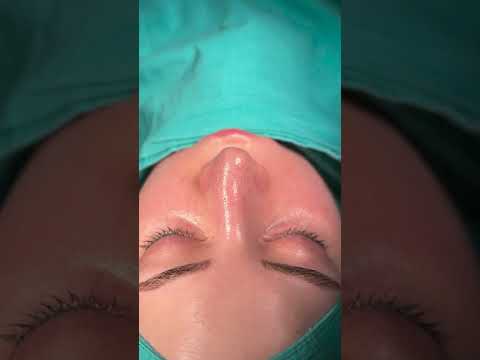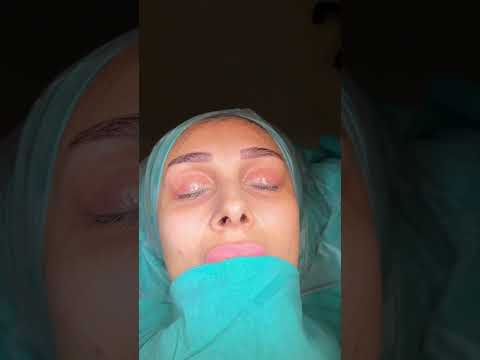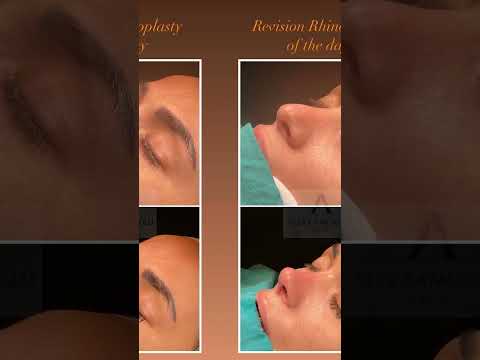Tipplasty in Turkey
Looking to refine the tip of your nose? Dr. Alev Camcıoğlu provides expert Tipplasty in Turkey, focusing on enhancing the nasal tip’s shape and projection. This specialized procedure is perfect for those who are satisfied with their overall nose but wish to improve the tip’s appearance. Trust our skilled team to deliver subtle changes that make a significant difference.
Cost of Tipplasty in Istanbul, Turkey ranges between €5,000– €7,000 in 2025 depending on hospital, package, and anatomy of your nose. Check our prices, before & after photos, and patient results from the USA, UK, Canada, Australia, and the rest of the world.
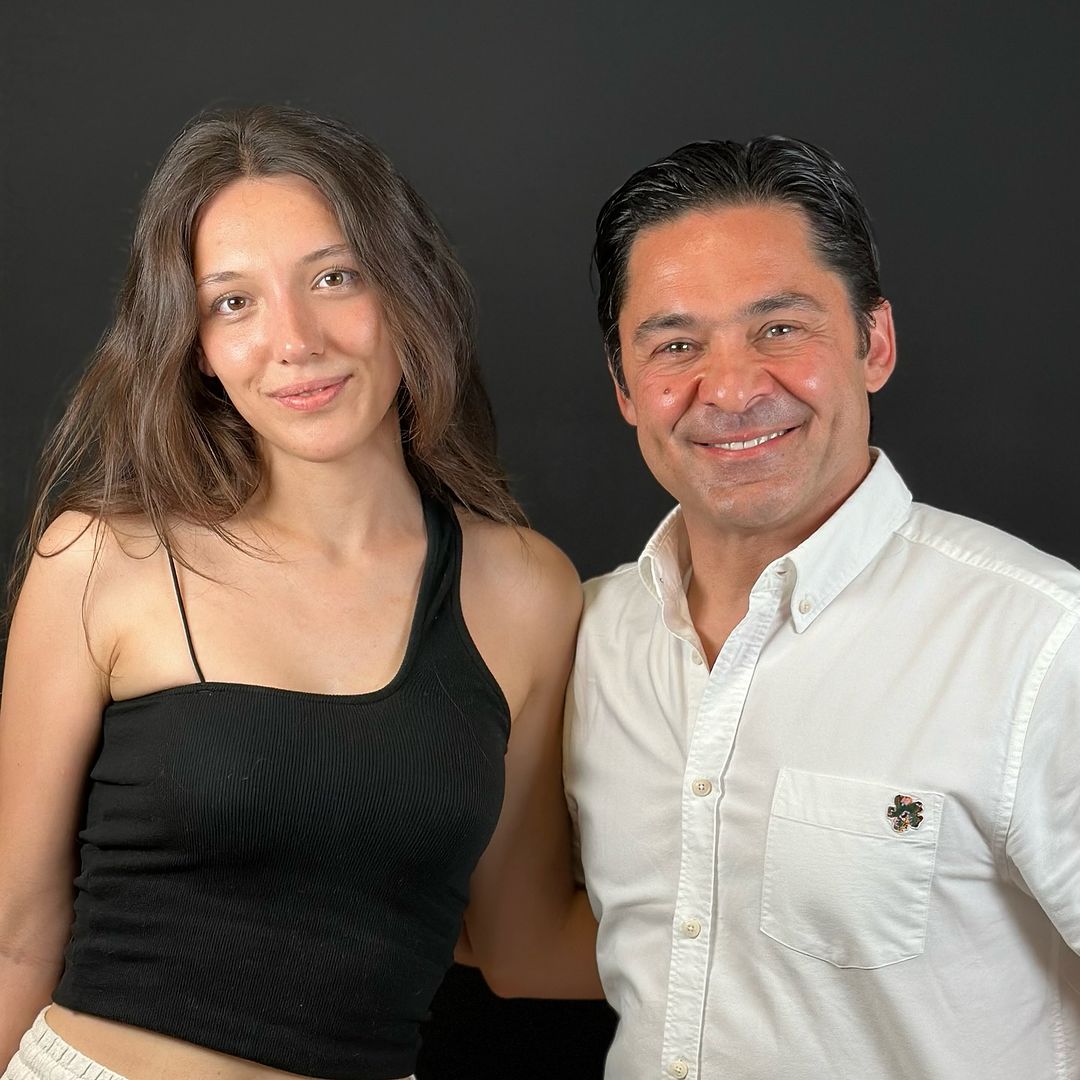
What is Nasal Tip Surgery?
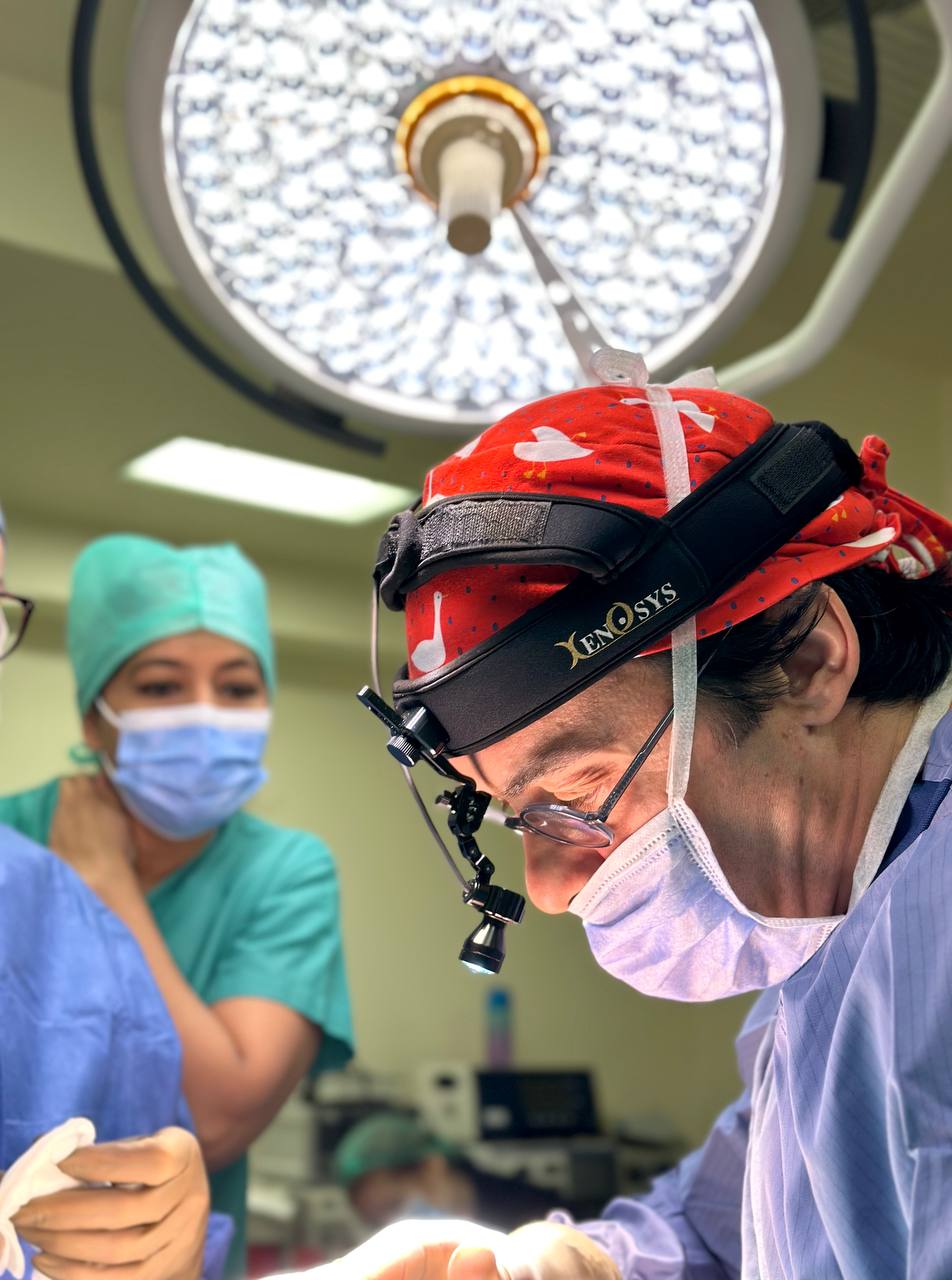
Nasal tip surgery holds a significant place in aesthetic surgery. Surgeons who perform this procedure aim to meet the aesthetic expectations of patients without compromising functionality. A successful tipplasty operation requires detailed anatomical knowledge. The surgeon must thoroughly understand the anatomical structure of the nasal tip and its relationships with surrounding tissues. Techniques applied during the procedure include:
- Tissue reshaping
- Strengthening support structures
- Corrections to improve aesthetic appearance
Each technique results in both aesthetic and functional outcomes. Proper application of surgical intervention ensures the preservation of the patient’s nasal functions. Particularly, improving the aesthetic appearance without affecting nasal breathing demonstrates the skill of the rhinoplasty surgeon. Consequently, nasal tip surgery addresses the aesthetic expectations of patients while maintaining a critical balance to preserve nasal functions.
What Are the Types of Tipplasty?
Tipplasty focuses solely on reshaping the nasal tip without altering the bridge or other structures. The main types include:
- Cartilage-Shaping Tipplasty
- Suture Tipplasty
- Graft-Based Tipplasty
- Reduction Tipplasty
- Closed Tipplasty
- Open Tipplasty
6 Reasons to Get Tipplasty in Istanbul






Post-OP
Care
Tipplasty Before & After Photos in Turkey
Nasal Tip Surgery: Basic Anatomical and Physiological Structures
Nasal tip surgery is an important component of facial aesthetics. Success in this procedure is achievable through a good understanding of the anatomical and physiological structures of the nasal tip. The basic anatomical structures of the nasal tip provide functional capacity while offering aesthetic improvements. A detailed examination of these structures forms the basis of rhinoplasty surgery.
Alar cartilages are the main structural elements of the nasal tip. These cartilages are critical factors influencing the shape, size, and strength of the nasal tip. Additionally, they determine the natural contour of the nasal tip and have a significant impact on aesthetic appearance. Alar cartilages can be examined in two main sections:
- Medial crura: Form the structure of the columella and merge with the nasal septum.
- Lateral crura: Located above the alar folds and determine the width of the nasal tip.
The domes situated between these cartilages define the highest point of the nasal tip and provide an aesthetic appearance. The dome structure is vital for the symmetry and aesthetic balance of the nasal tip.
In addition to cartilage structures, various mechanisms play a role in supporting the nasal tip. The main support mechanisms include:
- The shape, size, and strength of the alar cartilages themselves.
- The connection of the medial crura to the caudal septum.
- The connection of the cephalic edges of the lower lateral cartilages to the caudal edges of the upper lateral cartilages.
Besides, there are “minor” support mechanisms that support the nasal tip:
- Anterior nasal spine.
- Lateral sesamoid cartilages.
- Interdomal ligaments.
- Caudal membranous septum.
- Dorsal septum.
- The skin and soft tissue envelope covering the nasal tip.
These support systems work together to maintain the natural position and functionality of the nasal tip. Structurally, each of these factors may vary from patient to patient and should be considered in preoperative evaluation. In rhinoplasty surgeries, it is necessary to properly reestablish these support mechanisms. Overly aggressive surgical interventions can disrupt these support structures, leading to both aesthetic and functional problems.
Additionally, it is important to evaluate the effects on the caudal alar margins during the modification of alar cartilages. The alar margins do not contain any cartilaginous structure in the areas where the lower lateral cartilages curve cephalically. Therefore, interventions in this area can result in aesthetically undesirable changes such as alar retraction. Functionally, such damage can harm the external nasal valve and cause breathing problems post-surgery.
In Which Situations Can Tipplasty Be Applied?
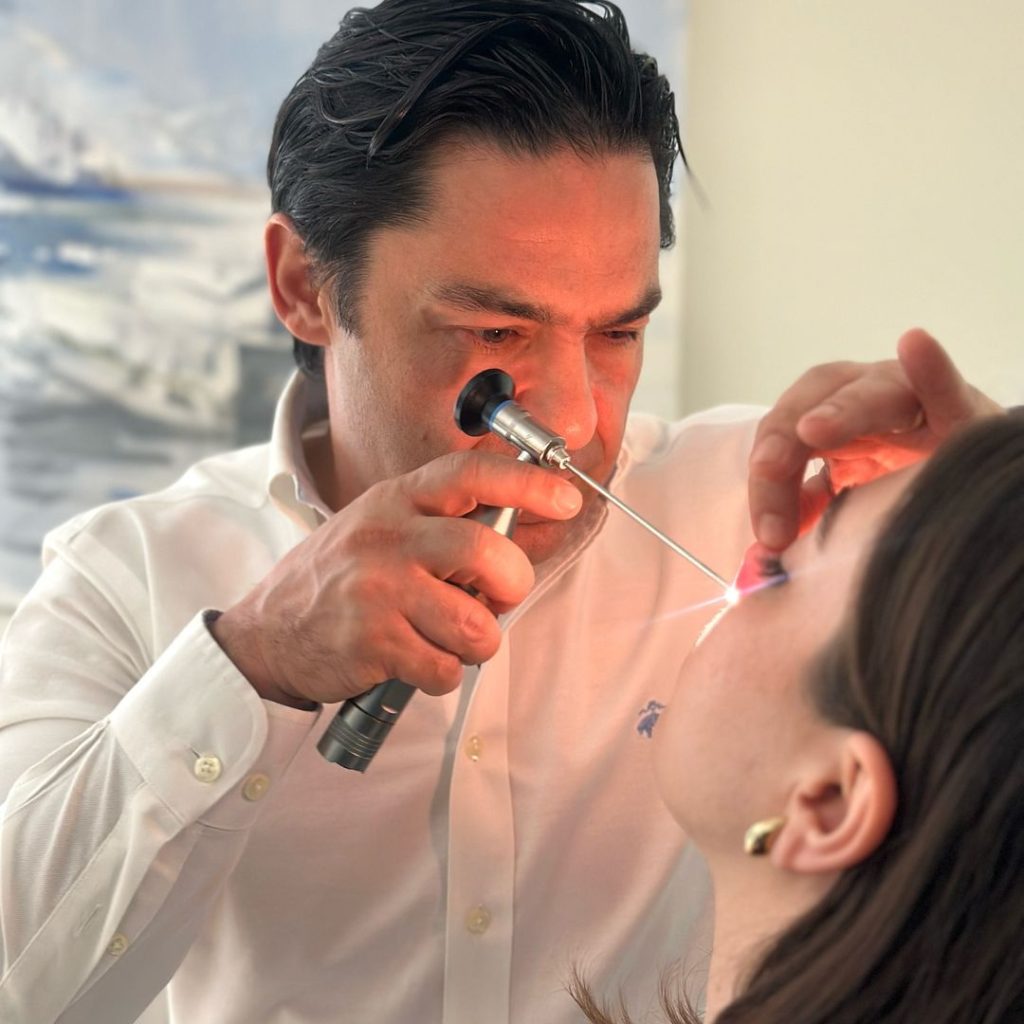
Tipplasty, also known as nasal tip aesthetics, is performed under certain aesthetic and functional conditions. Individuals who wish to achieve an ideal nasal appearance frequently choose this surgical method. Below, situations in which tipplasty can be performed are explained in detail.
Aesthetic Needs:
- If the nasal tip is too large or too small
- If the nasal tip is drooping or upturned
- If there is asymmetry or deformities in the nasal tip
- If undesirable appearances have occurred after previous nasal surgeries
These aesthetic concerns aim to make the facial features more balanced and proportional. Situations perceived as aesthetic problems often affect an individual’s self-confidence and cause discomfort in social relationships.
Functional Needs:
- Lack of structural support for the nasal tip
- Breathing problems such as nasal valve insufficiency
- Airway obstructions due to deformities in the internal structure of the nose
Functional improvements aim to facilitate breathing for the patient and improve overall quality of life. Tipplasty is a method that corrects the structure of the nose and provides functional improvements.
Psychological and Social Factors:
- Dissatisfaction with facial aesthetics
- Self-esteem issues due to the noticeable nasal structure in social settings
- Negative impact of aesthetic concerns on daily life and social interactions
Psychological and social factors play an important role in the decision for tipplasty. These interventions are recommended to help individuals feel better and be more comfortable in social environments.
Problems Arising from Previous Surgical Interventions:
- Patients dissatisfied with their first rhinoplasty surgery
- Deformities that have occurred after the surgery
- Functional problems that have developed in the nasal structure after surgery
Problems arising from previous surgical interventions can be corrected with tipplasty. The surgeon evaluates the problems caused by the patient’s previous surgeries and makes the necessary corrections.
When is Nasal Tip Surgery Not Appropriate?
Nasal tip surgery may be contraindicated under certain conditions. As with any elective surgery, rhinoplasty requires careful evaluation, and some conditions constitute contraindications for this type of intervention.
Firstly, the patient’s general health condition must be suitable. Elective rhinoplasty operations are generally performed under general anesthesia, and therefore, the patient must have a health profile suitable for anesthesia. Additionally, psychological factors also play an important role in the surgical decision-making process. Unrealistic expectations, serious psychological disorders, or body dysmorphic disorder are conditions where such an operation is not recommended. These conditions can lead to patient dissatisfaction with the results of the surgery.
During the preoperative planning stage, there must be open communication between the patient and the surgeon. The use of digital imaging and photographs can be helpful in determining the goals of the surgery but should not be considered a guarantee of postoperative results. These tools help manage expectations and increase the chances of identifying potential issues.
Revision or secondary surgical cases require special attention. These cases involve structures that have previously undergone surgical intervention, and the cartilage may be difficult to process. Situations requiring reconstruction can lead to serious complications:
- Disruption of vascular supply, which can cause skin necrosis
- Healing of tissues that is difficult to predict
- Requirement for a high level of surgical skill
Smoking also constitutes an important contraindication. Surgeons generally require patients to quit smoking before and after surgery to reduce the risk of complications and improve wound healing. In smoking patients, the risk of complications increases, so quitting smoking before surgery is essential.
What Equipment is Necessary for Nasal Tip Surgery?
The equipment used in tipplasty operations, or nasal tip surgery, is of great importance for the success of the surgical procedure. Each instrument serves a specific function at different stages of the operation. Initially, to apply local anesthesia:
- 1:100,000 epinephrine with 1% lidocaine
- Cotton swabs soaked with 0.05% oxymetazoline HCL or 4% cocaine
These ensure desensitization of the area before the procedure. Tools required for marking and cutting include:
- Fine-tipped skin marker
- Scalpel handles: #3 and/or #7 Bard-Parker Beaver scalpel handle
- Scalpel blades: #15, #15C, #6700 Beaver or similar
These cutting tools allow precise incisions on the skin and other tissues. Other important tools used to control bleeding and manipulate tissues during surgery include:
Bipolar electrocautery
Scissors:
- Wilmer
- Converse
- Giunta
- Joseph
- Iris
- Tenotomy
Various forceps are used to hold and position tissues:
Forceps:
- Adson-Brown
- Cushing-Brown bayonet forceps
- 5 mm Castroviejo
Retractors and speculums used to keep the surgical field open are also important:
Retractors:
- Aufricht
- Bernstein
- Gruber
Speculums:
- Cottle
- Vienna
- Killian
Other instruments required for tissue separation and manipulation include elevators and skin hooks:
Elevators:
- Woodson
- Cottle
- Freer
- Pierce
- Joseph
Skin hooks:
- Joseph 2, 7, and 10 mm
- Guthrie
Materials used for tissue arrangement and fixation after the operation include:
- Vacuum: 8 French Frazier tip
- Freer septal knife
- Cottle cartilage crusher
- Tebbetts caliper
- Needle holders:
- Halsey
- Webster
- Castroviejo
- Sutures:
- 6-0 polypropylene
- 6-0 plain gut
- 5-0 polydioxanone
- 5-0 chromic gut
- 4-0 chromic gut
- 3-0 nylon
- Septal splints
- Adhesive strips
- Thermal mold
What Are the Preparation Stages Before Nasal Tip Surgery?
Before nasal tip surgery, careful positioning of the patient on the operating table is essential. The patient should be securely placed in a supine position. During intubation, care should be taken to prevent the tube from deforming the nasal structure, and it should be carefully fixed to the midline of the lower lip. Additionally, the patient’s eyes should be protected against possible irritations:
- Adhesive film dressings
- Adhesive strips
Antiseptic solutions are used for surface sterilization:
- 10% betadine
- 70% isopropyl alcohol
These procedures are especially important to avoid damage to the corneas. Preparation is completed with the application of local anesthesia and placement of cotton swabs enriched with vasoconstrictor agents. These stages are critical for the success of the surgery.
What Methods Are Used in Nasal Tip Surgery?
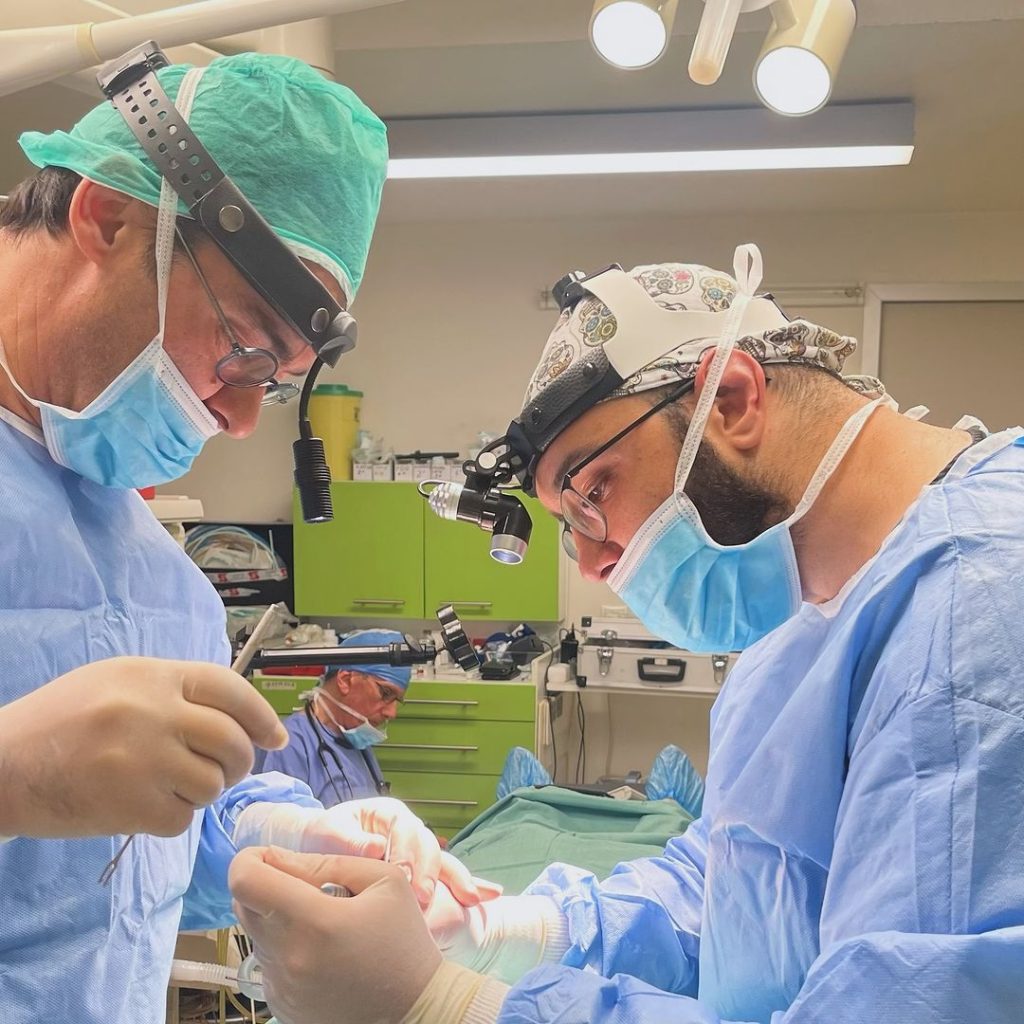
There are two main surgical approaches used in nasal tip surgery: closed and open approaches. Each method has its own variations and offers different advantages.
Closed approach:
- Divided into delivery and non-delivery categories.
- Non-delivery approaches:
- Provide minimal surgical exposure.
- Reduce the risk of swelling and deformity.
- Include two types of incisions: cartilage splitting and retrograde.
- Delivery approaches:
- Expose more alar cartilages.
- Create larger chondrocuteaneous flaps with intercartilaginous incisions.
- Overall, closed methods offer a faster recovery process.
- Allow for additional modifications to the geometry of the nasal tip.
- Minimize soft tissue manipulation and disruption of tip support.
Open approach:
- Provides complete exposure of the nasal framework.
- The skin-soft tissue envelope is lifted through a transcolumellar incision.
- Tip cartilages become fully visible and can be worked on in anatomical position.
- Disadvantages include columellar scar, prolonged edema, and increased operating time.
- Requires reconstruction to prevent disruption of anatomical support mechanisms.
- Especially preferred for teaching purposes in rhinoplasty.
Both approaches are preferred in specific scenarios for nasal tip surgery, and the surgeon should choose the most suitable one for the patient’s specific needs.
What Surgical Techniques Are Used?
Nasal tip reshaping is performed with various techniques, each offering specific results. This process, known as tipplasty, requires the expertise and creativity of the surgeon. Especially by rearranging the structures of the nasal tip, aesthetic changes are effectively achieved.
Tripod Theory:
- The tip is shaped with the support of two superolateral legs and one inferomedial leg.
- Interventions on the lateral legs mostly affect the rotation of the nasal tip.
- Changes on the medial leg directly affect projection.
Surgical Techniques:
- “Steal” techniques use suture recruitment to reposition cartilages.
- “Overlay” methods provide more dramatic changes by cutting the cartilages.
- Lateral crural stretching and repositioning techniques allow for more detailed adjustments.
These techniques allow the projection and rotation to be adjusted to the desired levels. Additionally, based on the nature of the surgical procedure, significant improvements can be made in the aesthetic profile of the nasal tip. Therefore, the surgeon should consider the unique needs of the patient when choosing among these different approaches. This process is of critical importance for enhancing the aesthetic appearance and optimizing functional outcomes. Thus, patient satisfaction is maximized while achieving a natural-looking result.
How Is Nasal Tip Projection Managed?
Nasal tip projection plays a critical role in maintaining aesthetic and functional balance. Surgical interventions use various techniques to either increase or decrease this projection. Adjustments to the projection are made by considering facial proportions and anatomical structures. Ideal projection ensures harmony with the natural aesthetics of the patient’s face and preserves functional integrity. The main techniques used in this process include:
Projection Increasing Techniques:
- Suture techniques
- Use of grafts
- Lateral crural steal
- Columellar struts
- Caudal septal extension grafts
Projection Decreasing Techniques:
- Lateral or medial crural overlay
- Reduction of the anterior septal angle
During projection adjustment, surgeons perform a detailed analysis of the nasal structure. The protrusion or retraction of the nasal tip has significant effects on the overall harmony of the face. Correcting excessive projection provides a more balanced appearance. Conversely, increasing insufficient projection helps improve the aesthetic profile of the nose.
How Is Nasal Tip Rotation Managed?
Managing rotation in nasal tip aesthetics is one of the finer details of aesthetic surgery. The rotation of the nasal tip significantly affects the aesthetic appearance of the profile. Ideal rotation should be suitable for the patient’s facial structure and ethnic background. Excessive rotation or insufficient rotation can lead to dissatisfaction among patients. Therefore, the surgeon should carefully plan the rotation. Techniques that can affect rotation include:
- Medial crural setback: Medial crura are set back using the tongue and groove technique.
- Lateral crural steal: Neodome is created by taking a part of the lateral crura.
- Lateral crural overlay: Lateral crura are shortened to achieve nasal tip rotation.
Additionally, other techniques used to position the nasal tip in the desired position include:
- Columellar struts and caudal septal extension grafts: Provide rotational force for the nasal tip.
- Triangular resection of the caudal septum: Used to increase rotation.
- Lateral crural stretching and repositioning: Used to position the tip correctly.
- Nasolabial angle filler: Expands the angle between the nose and upper lip.
Nuances of Tip Definition
Nasal tip aesthetics is a complex process that requires careful handling. Ensuring a natural appearance for each patient is essential. For this process to be successful, the surgeon must thoroughly analyze the cartilage structures. Proper application of techniques results in aesthetically pleasing outcomes while preventing functional issues. The main focuses of tip definition are listed below:
- Proper shaping of the lower lateral cartilages
- Necessary corrections for asymmetric cartilages
- Addition of grafts to support the ideal nasal tip
Firstly, a proper understanding of the anatomy of the lower lateral cartilages is essential. This ensures the tip definition remains natural and functional. Secondly, correcting the imbalances between the two alar cartilages is important as asymmetry is a common problem. Finally, in some cases, grafts may be used to support the nasal tip and provide a more defined definition. These grafts can be particularly effective in patients with thick skin and soft tissue.
How Is the Recovery Process Managed After Nasal Tip Surgery?
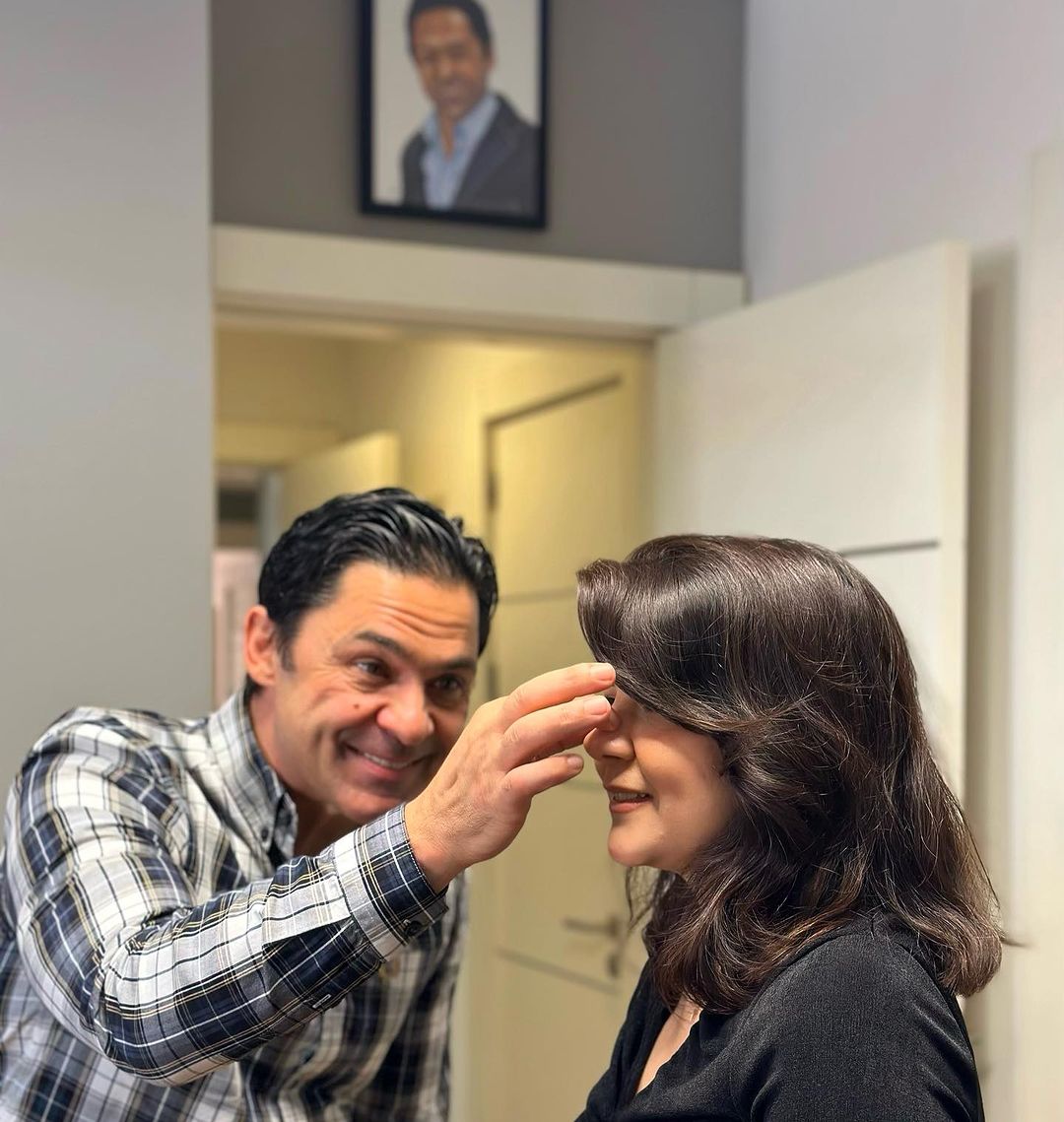
Post-operative care after nasal tip surgery plays a critical role in the success of the recovery process. Interventions made by the surgeon in the early post-operative period are of great importance. Taping the nasal tip and placing a thermoplastic splint on the back of the nose support recovery. At the end of the first week, all dressings and splints are removed, helping the patient to relax.
- Initial treatment methods include lateral wall splints to prevent possible complications.
- Swelling of the nasal tip, commonly encountered during the recovery process, can be a major concern for the patient.
- Recommended methods for managing swelling include self-applied massage, special taping techniques, and, if necessary, steroid injections.
During this process, factors such as diet, temperature, and physical activities can have a significant impact on swelling. Therefore, the patient is advised to be cautious of these variables. For long-term assessment of results, it is important to conduct regular follow-ups with standard digital photographs after the surgery. This allows the surgeon to evaluate the effectiveness of the applied techniques and the stability of the results.
What Are the Complications of Nasal Tip Surgery?
Possible complications after nasal tip surgery reveal the challenges of the operation. Especially in the first weeks, there is a risk of epistaxis and infection. These early problems require careful monitoring of the patient. Additionally, aesthetic concerns and issues related to breathing functions are frequently reported. Moreover, factors such as patient dissatisfaction and depression play a significant role during the recovery process. Long-term complications include adverse effects on the skin and soft tissues.
Early Complications:
- Epistaxis: Bleeding from the nose after surgery
- Infection: Risk of bacterial infection in the surgical area
Long-Term Complications:
- Skin Necrosis: Tissue death due to insufficient blood circulation in the skin
- Functional Problems: Breathing difficulties and other functional issues
- Aesthetic Dissatisfaction: Unmet aesthetic expectations after surgery
It may take months for the patient to adapt to the new nasal structure. During this period, it is important to be patient and maintain realistic expectations. Open communication between the surgeon and the patient is crucial in managing this process. If the results fall short of expectations and both parties mutually agree to identify the issues, revision surgeries may be planned. However, these surgeries should be scheduled at least six to twelve months after the first intervention. During this time, swelling decreases, and the healing process of the tissues can be better assessed.
How Much Does a Tipplasty in Turkey in 2025 ?
The cost of a Tipplasty in Istanbul, Turkey, typically ranges between €5,000 and €7,000. The price can vary depending on several factors, such as the surgeon's experience, the complexity of the procedure, the clinic's reputation, and additional services included in the package.
| Average Tipplasty Cost (in Euros) in 2025 | |
| United Kingdom | €16,600 – €19,000 |
| United States | €14,200 – €23,400 |
| Canada | €16,000 – €19,000 |
| Australia | €23,800 – €37,800 |
| South Korea | €9,400 – €17,200 |
| Ireland | €13,000 – €15,000 |
| Germany | €11,000 – €13,000 |
| Netherlands | €11,000 – €13,000 |
| France | €11,000 – €13,000 |
| Turkey | €5,000– €7,000 |
Frequently Asked Questions
How long does it take to recover from nasal tip surgery?
The full recovery time after nasal tip surgery usually ranges from six months to one year. During this period, it is important for the patient to follow the doctor’s recommendations. Especially in the first days, applying cold compresses to the nasal area and keeping the head elevated supports recovery. After the surgery, it is important to avoid touching the nasal area. If necessary, nasal sprays recommended by the doctor can be used. These guidelines positively affect the recovery process and help the patient go through a more comfortable recovery period.
Are tampons used in nasal tip surgery?
The use of tampons in nasal tip surgery is generally not necessary. However, some situations may constitute an exception; for example, if the patient experiences severe bleeding, tampons may be temporarily used to stop the bleeding. Still, these tampons should be removed by the doctor after the bleeding stops. Generally, nasal tampons are not preferred due to aesthetic considerations and are only used in mandatory cases.
Can the nasal tip be lifted without surgery?
Yes, the nasal tip can be lifted without surgery. For this procedure, gels containing hyaluronic acid are frequently preferred. Hyaluronic acid increases the skin’s ability to retain water, helping the nasal tip to appear more lifted. Thus, nasal aesthetics can be achieved without surgical intervention. This method is considered a minimally invasive technique and is usually completed quickly. The use of fillers provides a temporary but naturally looking improvement in the nasal structure.
How long does nasal tip surgery take?
The duration of nasal tip surgery usually varies between 20 minutes and one hour. The duration of the surgery depends on the procedure and the patient’s condition. Especially the amount and complexity of corrections in the nasal tip affect the duration of the operation. Therefore, the time may extend or shorten according to the patient’s needs. However, as a general rule, the time allocated for this type of surgery does not exceed one hour. Since each patient’s condition is different, the exact duration of the surgery is determined by the doctor.
Is nasal tip surgery risky?
Nasal tip surgery, like any surgical procedure, carries certain risks. Infections, bleeding, or complications related to anesthesia may occur. However, performing the operation by an experienced surgeon can minimize these risks. Additionally, it is crucial for the patient to have realistic expectations after the surgery. Unrealistic expectations can lead to disappointment for the patient. Therefore, it is important to be aware of these risks and receive detailed preoperative information before deciding on surgical intervention.
Is nasal tip lifting permanent?
The nasal tip lifting procedure is not permanent. However, this procedure can be repeated at the patient’s request. On average, the effects of a nasal aesthetic procedure with threads last about two years. At the end of this period, the threads used completely dissolve and disappear. Therefore, this method may not be recommended for those seeking a permanent solution. If a longer-lasting result is desired, the procedure may need to be repeated.
How is nasal symmetry achieved with nasal tip surgery?
In nasal tip surgery, symmetry is usually achieved through careful surgical planning. First, the surgeon evaluates whether the nasal cartilages and soft tissues are symmetrical. Then, the necessary corrections are made to reshape the nasal tip. If the nasal tip is asymmetric, the cartilages are repositioned or reshaped. Thus, a more symmetrical appearance of the nasal tip is achieved. Especially during nasal tip aesthetics, these adjustments enhance the overall aesthetic balance of the face.
When can one return to work after nasal tip surgery?
The time to return to work after nasal tip surgery can vary depending on the individual and the intensity of the work. Generally, patients can return to work within three to seven days after the surgery. During this period, light activities are recommended, as there may still be slight swelling or bruising in the facial area. The readiness to return to work depends on how well the individual feels. Therefore, tasks that do not require physical strain should be preferred during this period.
How much does nasal tip surgery cost?
The cost of nasal tip surgery varies depending on several factors. First and foremost, the experience and expertise of the surgeon are significant factors, with experienced surgeons generally demanding higher fees. Additionally, the costs of the clinic or hospital where the surgery will be performed can also affect the prices. The patient’s condition and needs, as well as the complexity of the surgery, can also influence the cost. Therefore, it is not possible to specify an exact price, but a clear cost will emerge based on personal evaluations.
Can only nasal tip surgery be performed?
Yes, only nasal tip surgery can be performed. Rhinoplasty is often thought of as involving the entire nose, but aesthetic procedures targeted solely at the nasal tip are also possible. Thus, nasal tip aesthetics can sometimes be performed without surgery using fillers. However, interventions on the cartilage tissue at the nasal tip can also be performed. The use of fillers is only a temporary solution. In conclusion, rhinoplasty can be applied solely to the nasal tip.
Who is suitable for nasal tip surgery?
Nasal tip surgery is suitable for people with nasal asymmetry, a drooping nasal tip, or a pinched nasal shape. Similarly, those with a wide nasal tip can benefit from this surgery. However, for individuals with more extensive problems such as a nasal hump, only nasal tip aesthetics may not be sufficient. Therefore, different surgical interventions may be required in cases that demand more significant changes to the nasal structure.
Do nasal tip lifting exercises work?
Unfortunately, nasal tip lifting exercises do not work. The reason is that the structure of the nose is composed of bone and cartilage, making it impossible to change the shape of the nose through exercises. Such changes can only be achieved through surgical interventions. Therefore, you cannot achieve the desired results with nasal tip lifting exercises. Surgical methods should be preferred for nasal aesthetics. Moreover, there is no medical basis for nose exercises. Therefore, exercises should not be relied upon to change the shape of the nose.
One of the Best Clinic Team for Tipplasty in Turkey
Dr. Alev Camcıoğlu is considered to be one of the best Tipplasty surgeon in Turkey. You can check Tipplasty reviews here.

Op. Dr. Alev Camcıoğlu
Rhinoplasty Surgeon

Aylin Uyuşmak
Clinical Coordinator

Serra Sevgili
Clinical Assistant

Sema Yapıcı
Operating Room Nurse



